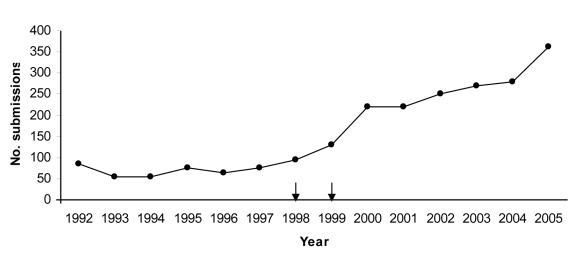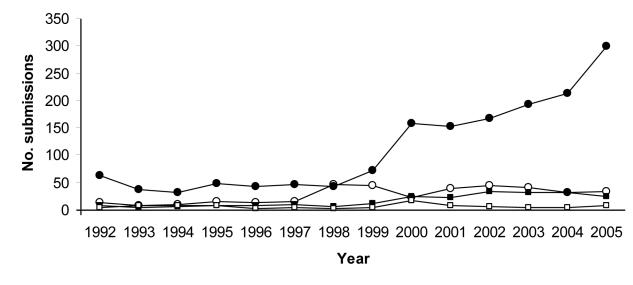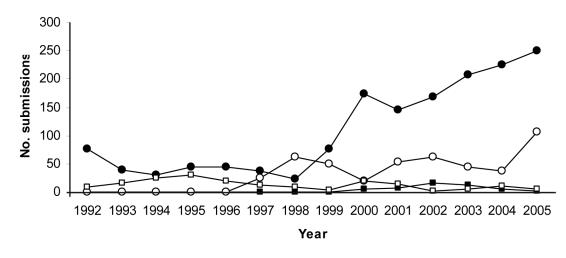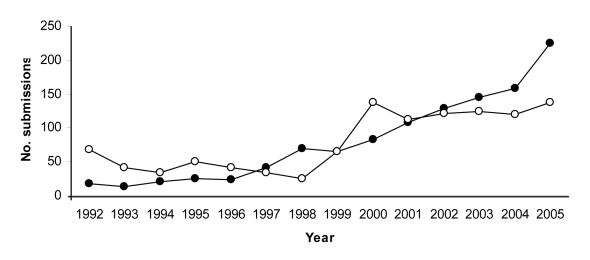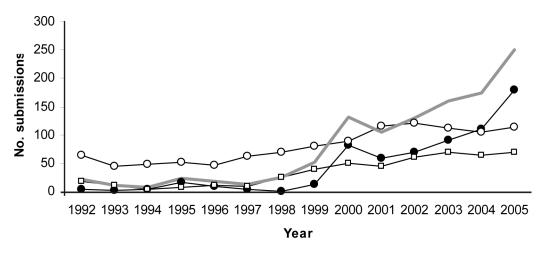The Croatian Medical Journal (CMJ) is in its 15th year of life – a time to stop and see how we are doing and what the future may be bringing. The CMJ has been started in 1992 to provide a window into medical research in small and developing communities, but also to serve as the doors for small scientific communities into the mainstream science (1). To fulfill these goals, we primarily focused our editorial efforts on education of our authors, both present and future, about scientific research and publishing, especially the presentation of research results (2-4).
The most important step in bringing research from small and developing medical scientific communities to the mainstream science was the inclusion of the journal in international bibliographic databases (5) and making the journal available in free full text on the Internet (1,5,6). Especially relevant for the editorial work in the journal was the inclusion in two major bibliographic databases: PubMed/Medline in 1998, and databases of the then Institute for Scientific Information, now Thomson Scientific, in 1999. These years clearly demarcate two different editorial periods in the CMJ (Figure 1): period of slow development and period of intense growth and editorial activity in the journal.
Figure 1.
Total number of manuscripts submitted to the Croatian Medical Journal from 1992 to 2005. Arrows indicate indexing of the journal in the PubMed/Medline (1998) and Thomson Scientific databases (1999).
Secular trends in manuscript submissions to the journal
From 1992 to 1999, the annual number of submissions ranged from 55 to 100. After 1999, the year of indexing in Thomson Scientific databases and of making the full text of the journal available on the Internet, there is a constant increase in the annual number of submissions, reaching 363 in 2005. Most of the submitted manuscripts described original research (Figure 2), and their number steadily increased from 2000. However, the proportion of manuscripts with original research was fairly constant, ranging mostly from 60 to 70% of all submissions. Case reports constitute about 10% of all submissions and editorial material and other types of special manuscripts another 20%.
Figure 2.
Type of manuscripts submitted to the Croatian Medical Journal from 1992 to 2005: original articles (closed circles), editorial material (open circles), case reports (closed squares), and other (open squares; includes medical ethics, history of medicine, medical education, war medicine, communication in medicine, and legal medicine).
An important change after 1999 was in the way of manuscript submissions (Figure 3). Most of the articles in all years (around 70%) were submitted independently of any special call for a thematic issue or editorial invitation. The number of these independent submissions greatly increased in 2000. Before that, the journal did not have enough articles to build up thematic issues. After 1998, when we published our first thematic issue, joining the JAMA in its global theme on aging, we have been getting almost 30% annual submissions related to the thematic issues.
Figure 3.
Manuscripts submitted to the Croatian Medical Journal according to the type of submission: independent submissions (closed circles), student CMJ (closed squares), thematic issue (open circles), or solicited by editors (open squares).
The third characteristic of manuscripts submitted to the CMJ, in addition to being original articles submitted independently, is that they are predominantly on clinical research (Figure 4). During the whole life of the CMJ, manuscripts describing results from clinical research constituted an average of 60% of all submission. Again, their number greatly increased after 1999. In addition to clinical researchers, researchers in public health also recognized the CMJ as a potential publication place, with more than 20% of all submissions to the journal.
Figure 4.
Manuscript submissions to the Croatian Medical Journal according to the research field: clinical sciences (closed circles), basic sciences (closed squares), public health (open circles), and other (open squares).
In 2000, another important change in the submission trends occurred: increase of manuscript submissions outside of Croatia (Figure 5). During the first 6 years of the journal, manuscripts from Croatia were the majority of submissions. In 2000, after the inclusion in databases important for academic and research advancement in Croatia, especially in view of a promising impact factor of the CMJ (7-9), there was a great increase in submissions from Croatia, with 137 manuscripts from Croatia submitted to the journal (Figure 5). From then on, the number of manuscript submission from Croatia leveled at 100 to 130. On the contrary, the proportion of non-Croatian submissions steadily increased, from 21% in 1992 to 62% in 2005. We did not specifically analyze the countries of origin, but we see increase in submissions both from the developed and developing countries in recent years. For Croatian authors, it seems that medical research community, ie, its clinical researchers have reached the upper limits of their publication productivity for publication in the CMJ.
Figure 5.
Submissions to the Croatian Medical Journal from Croatian (open circles) and non-Croatian (closed circle) affiliations. Non-Croatian origin of the manuscript was defined as at least one non-Coatian affiliation of the authors in the byline.
Fate of submitted manuscripts – the role of editors and reviewers
Greater visibility of the CMJ and growth in submissions substantially changed the editorial work and the ways of making decision on acceptance and publication of submitted manuscripts (Figure 6). During the first years, when the number of submissions was low, most of them were sent out for peer-review and the editorial decision was made after receiving comments from the reviewers (10,11), with less than 10% of editorial rejections (Figure 6). From 2000 onward, there is a constant increase in editorial rejection, reaching almost 50% in 2005. Editorial rejection did not mean that we changed our close relationship with the authors and our assistance to them to improve data presentation in their articles (11), but we had more good articles to choose from, and some submissions did not have good-enough data to stand the strict review evaluation. Our policy in cases of editorial rejection is to send the authors detailed comments on their article and suggestions for its improvement, sometimes even with the suggestion of another journal to which they can submit their manuscript. Manuscript rejection after review also increased in absolute numbers after 1999, but always constituted around 20% of all editorial decision. The number of accepted and published papers after peer review decreased in relative terms, from 74% in 1992 to 31% in 2005, but the absolute number of published papers ranged from 44 to 79 during 1992-1999; after the increase in submissions in 2000, we were able to reach our goal of publishing around 100 articles per year.
Figure 6.
The fate of manuscripts submitted to the Croatian Medical Journal from 1992 to 2005: editorial rejection (full circles), rejection after review (open squares), and acceptance after review (open circles); gray line – all rejections (editorial + after review).
The rejection rate of the CMJ increased from the average of 27% in 1992-1999 to 59% in 2000-2005, with the highest rejection rate of 69% in 2005. The increase in the rejection rate was similar for all types of submissions, including the type or manuscript, field of research, submission type, and country of origin (Table 1).
Table 1.
Rejection rate of manuscripts submitted to the Croatian Medical Journal
| Type of submission | Rejection rate (%) |
||
|---|---|---|---|
| total (n = 2236) | 1992-1999 (n = 634) | 2000-2005 (n = 1602) | |
| Manuscript type: | |||
| original articles | 52.9 | 27.7 | 60.9 |
| editorial material | 35.2 | 25.2 | 42.9 |
| case reports | 62.1 | 32.8 | 72.3 |
| other | 26.8 | 13.2 | 38.6 |
| Field of research: | |||
| basic sciences | 39.9 | 15.7 | 54.2 |
| clinical sciences | 57.0 | 31.2 | 65.9 |
| public health | 43.5 | 21.6 | 51.7 |
| other | 33.5 | 25.8 | 38.1 |
| Submission type: | |||
| independent | 62.7 | 34.7 | 71.6 |
| thematic issue | 25.6 | 19.0 | 28.4 |
| student CMJ | 6.3 | 0.0 | 6.3 |
| solicited | 14.3 | 11.2 | 21.1 |
| Origin of manuscript: | |||
| Croatian | 51.6 | 31.8 | 61.0 |
| non-Croatian | 48.3 | 20.0 | 57.4 |
The future
What can we learn from the past 15 years about the future of the CMJ? One thing is certain: the CMJ has opened the window into small medical research communities all over the world and the door for the authors from these communities to join the mainstream science. The CMJ has respectable position among general medical journals. Its impact factor is around the median impact factor of the 103 journals from the Thomson Scientific Journal Citation Records’ section Medicine, General and Internal (8,9). Our calculations for the 2005 put the impact factor over 0.8. But the CMJ’s readers and authors must not expect that its impact factor will continue to grow and reach the impact factor of major medical journals. In 2004, for which the latest Journal Citation Records are available, only 5 out of 103 journals had the impact factor greater than 10, and 9 more had the impact factor greater than 3. Regarding the size, circulation, readership, and authorship of the CMJ, as well as citation dynamics in general medical journals, CMJ’s impact factor cannot be much over 1. We do not want to sacrifice our primary goal of serving as the bridge between the scientific periphery and the mainstream science and as an education center for research in small scientific communities (2,3) so that we could possibly increase the impact factor. For us, the future means opening new doors and windows, into areas such as research integrity (12), education in scientific writing (3), and excellence in publishing clinical research (13). This will all depend on the quality and number or articles we receive. But, the game of scientific publishing does not count past benefits. Like in soccer leagues, each new year gives the winners and losers the same chance. CMJ has to prove each year that it deserves the trust of its authors and readers. And each year we try our best.
References
- 1.Marušić A, Mišak A, Kljaković-Gašpić M, Marušić M. Educatione ad excelentiam – ten years of the Croatian Medical Journal. Croat Med J. 2002;43:1–7. [PubMed] [Google Scholar]
- 2.Marušić A, Marušić M. Small scientific journals from small countries: breaking from a vicious circle of inadequacy. Croat Med J. 1999;40:508–14. [PubMed] [Google Scholar]
- 3.Marušić M, Marušić A. Good editorial practice: editors as educators. Croat Med J. 2001;42:113–20. [PubMed] [Google Scholar]
- 4.Lukić IK, Marušić M. Appointment of statistical editor and quality of statistics in a small medical journal. Croat Med J. 2001;42:500–3. [PubMed] [Google Scholar]
- 5.Marušić M, Martinić Blase E, Marušić A. Croatian Medical Journal at the turn of the millennium. Croat Med J. 2000;41:5–27. [PubMed] [Google Scholar]
- 6.Marušić A, Marušić M. Double life of medical journals: Dr Paper and Mr Web. Croat Med J. 2006;47:4–6. [PMC free article] [PubMed] [Google Scholar]
- 7.Mišak A, Petrak J, Pećina M. Scientific biomedical journals in Croatia. Croat Med J. 2002;43:8–15. [PubMed] [Google Scholar]
- 8.Kovačić N, Mišak A. What can be learned from impact factor of Croatian Medical Journal, 1994-2003? Croat Med J. 2004;45:13–7. [PubMed] [Google Scholar]
- 9.Kovačić N. Structure of the 2003 impact factor for Croatian Medical Journal. Croat Med J. 2004;45:671–3. [PubMed] [Google Scholar]
- 10.Marušić A, Meštrović T, Petrovečki M, Marušić M. Peer review in the Croatian Medical Journal from 1992 to 1996. Croat Med J. 1998;39:3–9. [PubMed] [Google Scholar]
- 11.Marušić A, Lukić IK, Marušić M, McNamee D, Sharp D, Horton R. Peer review in a small and a big medical journal: case study of the Croatian Medical Journal and the Lancet. Croat Med J. 2002;43:286–9. [PubMed] [Google Scholar]
- 12.Katavić V. Five-year report of Croatian Medical Journal’s Research Integrity Editor – policy, policing, or policing policy. Croat Med J. 2006;47:220–7. [PMC free article] [PubMed] [Google Scholar]
- 13.International Committee of Medical Journal Editors Clinical trial registration: A statement from the International Committee of Medical Journal Editors. Croat Med J. 2004;45:526–7. [PubMed] [Google Scholar]



